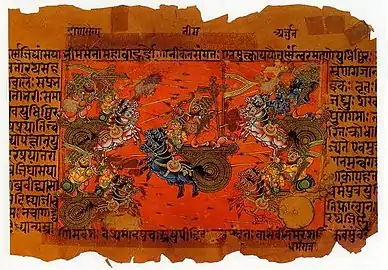Dhrishtadyumna
Dhrishtadyumna (Sanskrit: धृष्टद्द्युम्न, dhṛṣṭadyumna, lit. he who is courageous and splendorous), also known as Draupada (Sanskrit: द्रौपद, lit. son of Drupada), is a character of the Hindu epic Mahabharata. He was born along with his sister, Draupadi, from a yajna organised by king Drupada of Panchala. He was the commander-in-chief of the Pandava army during the entire Kurukshetra War i.e. for 18 days. Dhrishtadyumna killed Drona, the royal guru, when he was weeping and meditating in the ongoing battle, which was against the rules of engagement.[1]
| Dhrishtadyumna | |
|---|---|
| Mahabharata character | |
 Dhrishtadyumna, the commander in chief of Pandava Army | |
| In-universe information | |
| Family | Draupadi (sister); Drupada(father) Shikhandi (sister later brother) Satyajit (brother) |
| Children | Kshatradharman, Kshatravarman, Kshatranjaya and Dhrishtaketu (sons) |
| Relatives | Pandavas (Brothers in law) |
| Home | Panchala |
Birth

After Pandavas and Kauravas completed their training under Drona, they were asked by Drona to attack and defeat Drupada as Gurudhakshina. Arjuna defeated Drupada. After Drupada's defeat, Panchala was divided into two parts. The enraged Drupada sought vengeance. None of Draupada's children could defeat Drona. So, he performed a yajna (sacrifice) to obtain a son, capable of killing Drona. From the holy flames of the yajna emerged a full-grown man, who shone like the fire. The armoured youth held a sword and a bow in his hands. Drupada named him Dhrishtadyumna. After Dhrishtadyumna, a beautiful maiden Draupadi rose from the fire.[2]
After some time, Drona visited Panchala and met Dhrishtadyumna. Even though Dhrishtadyumna was prophesied as the slayer of Drona, he was accepted as a student by Drona; he learned advanced military arts.[3]
Draupadi's Swayamvar

Dhrishtadyumna hosted his sister Draupadi's swayamvar and told its rules to the kings and princes. When a young Brahmin won Draupadi in front of all the princes and nobility, Dhrishtadyumna secretly followed the Brahmin and his sister, only to discover that the Brahmin was in fact Arjuna, one of the five Pandava brothers.[4][5]
Marriage and children

Dhrishtadyumna had multiple wives.[6] He had 4 sons - Kshtradharman,[7] Kshatravarman,[8] Kshatranjaya[9] and Dhrishtaketu.[10] The first 3 were killed in the Kurukshetra War by Drona, whereas Dhrishtaketu was killed by Karna.[11]
Kurukshetra War
Dhristadyumna was appointed as the Senapati (commander-in-chief) of the Pandava Army in the Kurukshetra War against the Kauravas. He maintained his position till the end of the war. On the 15th day of the war, Drona killed Drupada. The Pandavas deceived a plot to capitalize on Drona's only weakness, his son Ashwatthama. The Pandava Bhima killed an elephant named Ashwatthama. The Pandavas spread the rumour of Ashwatthama's death. When Drona approached the eldest Pandava Yudhishthira, he confirmed that Ashwatthama was killed, but murmured that it's the elephant; the latter part of his reply was overshadowed by conches of Pandava warriors. Thinking his son had died, Drona was heartbroken and surrendered his weapons. Drona sat down, started to meditate and his soul left his body in quest of Ashwatthama's soul. Dhristadyumna took his sword and decapitated Drona, killing him.[12][13][14][15]
Death
On the 18th night of the war, Ashwathama attacked the Pandava camp during the night, and killed Dhristadyumna. As Dhristadyumna begs for an honourable death, asking to die with a sword in his hand, Ashwathama ignores him, proceeding to beat and smother him to death by beheading him.[16]
Analysis
In one of the many side-stories of the Mahabharatha, there is a drama centred around the fact that Dhrishtadyumna, despite not being Drupada's eldest, is his heir. While Drupada and others give many reasons for this, it is implied that the real reason is that Dhristadyumna has a godly parent, and thus more coveted as a ruler since his rule would seem more blessed. Dhristadyumna somewhat internalizes this, looking down upon Satyajit's pacifism and Shikhandi's single-minded hatred of Bhisma. He makes a point out of never bowing to or respecting his siblings, never wanting to legitimize any claim to Panchal they might have.[17]
References
- "Positive thinking: Dhrishtadyumna". DNA. 7 December 2012.
- Narasimhan, Chakravarthi V. (1999). The Mahābhārata: An English Version Based on Selected Verses. Motilal Banarsidass Publ. ISBN 978-81-208-1673-2.
- "Dhrishtadyumna". en.krishnakosh.org. Retrieved 15 September 2020.
- Kapoor, Subodh (November 2004). A Dictionary of Hinduism: Including Its Mythology, Religion, History, Literature and Pantheon. Cosmo Publications. ISBN 978-81-7755-874-6.
- Rao; Rameshwar, Shanta (1985). Mahabharata, The(Illustrated). Orient Blackswan. ISBN 978-81-250-2280-0.
- "The Mahabharata, Book 10: Sauptika Parva: Section 8". www.sacred-texts.com.
- "The Mahabharata, Book 7: Drona Parva: Dronabhisheka Parva: Section XXIII". www.sacred-texts.com.
- "Kshatravarman, Kṣatravarman, Kshatra-varman: 1 definition". www.wisdomlib.org. 9 March 2019.
- "Kshatranjaya, Kṣatrañjaya: 1 definition". www.wisdomlib.org. 13 March 2019.
- "Dhrishtaketu, Dhrishta-ketu, Dhṛṣṭaketu: 9 definitions". www.wisdomlib.org. 29 June 2012.
- "Dhrishtadyumna, Dhrishta-dyumna, Dhṛṣṭadyumna: 9 definitions". www.wisdomlib.org. 29 June 2012.
- Buck, William (2000). Mahabharata. University of California Press. ISBN 978-0-520-22704-0.
- "Dhrishtadyumna". Glorious Hinduism. 11 November 2016. Retrieved 15 September 2020.
- Vishwananda, Paramahamsa Sri Swami (12 January 2017). Shreemad Bhagavad Gita: The Song of Love. Bhakti Marga Publications. ISBN 978-3-940381-70-5.
- Porwal, Gunjan (12 September 2018). Ashwatthama's Redemption: The Rise of Dandak. Om Books International. ISBN 978-93-5276-635-2.
- K M Ganguly (1883-1896). The Mahabharatha Book 10: Sauptika Parva section 8 Ashwatthama killing Dhrishtadyumna, October 2003
- Debroy, Bibek (June 2015). The Mahabharata, Volume 4. United Kingdom: Penguin Books.
